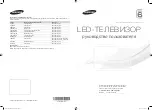
Service Modes, Error Codes, and Fault Finding
5.
5.5
Error Codes
5.5.1
Introduction
Error codes are required to indicate failures in the TV set. In
principle a unique error code is available for every:
•
Activated (SW) protection.
•
Failing I
2
C device.
•
General I
2
C error.
The last five errors, stored in the NVM, are shown in the
Service menu’s. This is called the error buffer.
The error code buffer contains all errors detected since the last
time the buffer was erased. The buffer is written from left to
right. When an error occurs that is not yet in the error code
buffer, it is displayed at the left side and all other errors shift one
position to the right.
An error will be added to the buffer if this error differs from any
error in the buffer. The last found error is displayed on the left.
An error with a designated error code never leads to a
deadlock situation. It must always be diagnosable (e.g. error
buffer via OSD or blinking LED).
In case a failure identified by an error code automatically
results in other error codes (cause and effect), only the error
code of the MAIN failure is displayed.
5.5.2
How to Read the Error Buffer
You can read the error buffer in three ways:
•
On screen via the SAM/CSM (if you have a picture).
Example:
–
ERROR: 000 000 000 000 000: No errors detected
–
ERROR: 013 000 000 000 000: Error code 13 is the
last and only detected error
–
ERROR: 034 013 000 000 000: Error code 13 was
detected first and error code 34 is the last detected
(newest) error
•
Via the blinking LED procedure (when you have no
picture). See paragraph
5.6 The Blinking LED Procedure
5.5.3
Error codes
In this chassis only “layer 2” error codes are available and point
to problems on the SSB. They are triggered by LED blinking
when CSM is activated. Only the following layer 2 errors are
defined:
Figure 5-2 Error code overview
5.5.4
How to Clear the Error Buffer
The error code buffer is cleared in the following cases:
•
By using the CLEAR command in the SAM menu
•
By using the CLEAR command in the Factory mode:
•
By using the following key sequence on the remote control
transmitter: “062599” directly followed by the OK button.
•
If the contents of the error buffer have not changed for 50
hours, the error buffer resets automatically.
Note: If you exit SAM by disconnecting the mains from the
television set, the error buffer is not reset.
De
scrip
tio
n
LAYER
1 error
LAYER
2 error
Mo
nito
red
Medi
um
E
rror/
I²C
a
ddre
ss
EB
: in error
bu
ffe
r
BL: Blin
kin
g LED
Dev
ice
Defectiv
e
bo
ard
Pr
ot
.
I²C BUSSES
I²C 0 (SSB bus)
2 13
SOC I²CM0
E
BL/EB SSB
SSB
I²C MCU (BE bus) 2 14 SOC I²CMCU
E
BL/EB
SSB
SSB
I²C 2 (FE bus)
2 15 SOC I²CM2
E
BL/EB SSB
SSB
I²C 1 (SFR bus)
2 18
SOC I²CM1
E
BL/EB SSB
SSB
SOC doesn’t boot
(HW cause)
2 15
St-by µP
P
D4
BL
MT5593
SSB
Supply related:
12V
3 16
St-by µP
I/O
P
BL
Supply
Display supply
(POK)
3 17 SOC I/O
E
EB
Supply
SSB
I2C switch 2
24
SOC I²CMCU
E E0
EB
PCA9540
SSB
Channel dec
2 27 SOC I²CM2
E
D8-DC EB Silab Si216x
SSB
Boston (HDMI2.2)
2
29
SOC I²CM0
E 64
EB SIL 9777
SSB
Lnb controler
2
31
SOC I²CM2
E 10
EB LNBH
25 SSB
Kleernet (Wire
less
Audio)
2
32
SOC I²CM1
E
EB
SSB
DTV Tuner 2
34
SOC I²CM2
E
C0
EB
Silab Si2157
(H/T models)
Sony Helene
(K/S models
)
SSB
Tuner DVB-S2 2 36
SOC I²CM2
E
C6
EB STV 6111
SSB
Class-D 2
37
SOC I²CM3 E
36 EB
TAS 5731
PHP
SSB
FPGA PQ
2
38
SOC I²CMCU
E
84 EB
Durango
SSB
2nd Audio
amplifier
2
39
SOC I²CM3? E
EB
SSB
T° sensor SSB/set
2 42 SOC I²CM1
E 98 EB LM
75
T°sensor
Light sensor
6
43
SOC I²CM3 E
72
EB
TSL2571
SET
SOC doesn’t boot 2
53
St-by µP
P
D4
BL
MT5593
SSB
















































